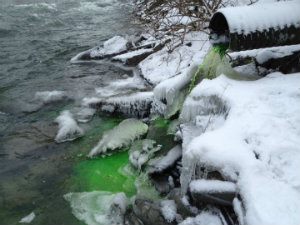
In 2000, the Vermont Legislature required DEC to implement a statewide program to promote detection and elimination of improper or illegal connections and discharges. Illicit discharges are discharges of wastewater or industrial process water into a stormwater-only drainage system. The Legislature's intent was to expand illicit discharge detection and elimination (IDDE) efforts from the communities—all in the greater Burlington area—required to perform IDDE in compliance with the EPA’s Phase 2 Stormwater Rule to encompass all developed areas of the Vermont. Following the Legislature's mandate, DEC has assisted municipalities not subject to the Phase 2 Stormwater Rule by mapping drainage systems and performing IDDE. This work, funded through CWIP ecosystem restoration grants, USEPA Section 319, Supplemental Environmental Fines and the Lake Champlain Basin Program, has been completed for all major urbanized areas in the Missisquoi, Lamoille, Winooski (outside the greater Burlington area), Otter, Poultney, Passumpsic Rivers, the Lake Memphremagog Basin, and the Connecticut River Basin, and the Hoosic River Basin. . It is ongoing in the West-Williams-Saxton-Lower Connecticut River, Deerfield and Hoosic River Basins.
About one-hundred and seventy six communities have had GIS (Geographic Information System) drainage maps completed. Stone Environmental, Watershed Consulting Associates and Aldrich-Elliott Engineers in conjunction with several watershed associations (Memphremagog Watershed Association, Friends of the Winooski River and Friends of the Mad River) have or are currently conducting IDDE surveys in forty-four non-designated MS4 (municipal separate storm sewer system) communities. Consultants have identified 5,091 discharge points, 1,468 of which were flowing when inspected. A wastewater source was indicated at 243 discharge points. Other types of contamination included petroleum, treated drinking water, heated water, pet waste, mop water, paint and road salt. By combining drainage mapping, environmental investigative work, and municipal cooperation, this effort has eliminated numerous wastewater discharges, decreasing phosphorus by an estimated 275 kg per year to Lake Champlain, and reducing the risk of pathogen exposure.
Stormwater Master Plans (SWMP) have been completed for about 70 geographic areas including watersheds, subwatersheds, towns and villages. Available plans can be found below and are posted by the Town Name in which they are located.
